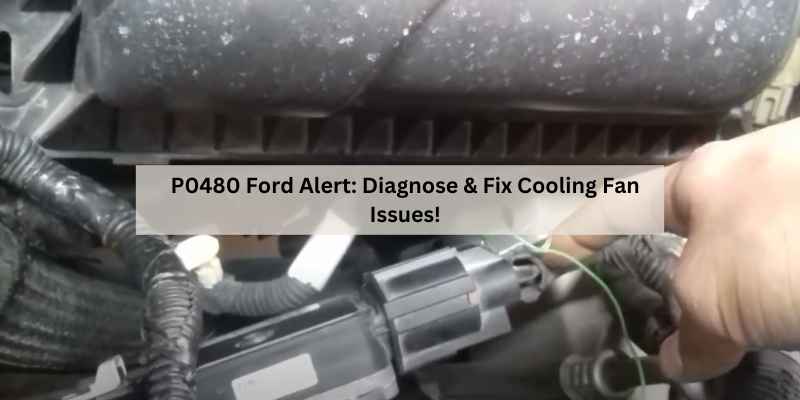P0480 Ford Alert: Diagnose & Fix Cooling Fan Issues!
The P0480 code in Ford vehicles indicates a problem with the cooling fan control circuit. This issue typically relates to the fan relay or wiring.
Understanding the P0480 code is crucial for Ford vehicle owners. This diagnostic trouble code (DTC) signals a malfunction in the cooling fan control circuit, which can lead to overheating. The cooling fan plays a vital role in maintaining optimal engine temperature.
When the fan fails to operate correctly, it can cause serious engine damage. Common causes include a faulty fan relay, wiring issues, or problems with the engine coolant temperature sensor. Addressing the P0480 code promptly can prevent further complications and ensure your vehicle runs smoothly. Regular maintenance and timely repairs can enhance the longevity of your Ford.
Introduction To P0480 Ford Alert
The P0480 Ford alert signifies a problem with the cooling fan circuit. Recognizing the symptoms early can prevent further damage. Common signs include overheating, erratic fan behavior, and unusual engine noises. These symptoms indicate that the cooling system is not functioning properly.
Addressing the P0480 alert is crucial. Ignoring it can lead to severe engine damage. Regular maintenance can help identify issues early. Timely repairs ensure the vehicle runs efficiently. This can also save money on extensive repairs later. Always consult a professional mechanic if symptoms arise.
Diagnosing The P0480 Code
To diagnose the P0480 code, specific tools are essential. A digital multimeter measures voltage and continuity. An OBD-II scanner helps read error codes. Use a wire harness tester to check connections.
Follow these steps for diagnosis:
- Start by scanning the vehicle with an OBD-II scanner.
- Check the fan control relay for faults.
- Inspect the wiring and connections closely.
- Test the engine coolant temperature sensor.
- Examine the VSS sensor for any issues.
Common Causes Of P0480 In Ford Vehicles
Faulty VSS Sensor often causes P0480 in Ford vehicles. This sensor helps the engine control module (ECM) monitor vehicle speed. If the VSS sensor fails, it can lead to incorrect readings. This may trigger the P0480 code, causing the engine to overheat.
Engine Coolant Temp Sensor Issues also contribute to this problem. This sensor measures the coolant temperature. If it malfunctions, it may send wrong data to the ECM. This can cause improper fan operation, resulting in overheating.
| Common Solutions |
|---|
| Replacing the VSS Sensor |
| Replacing the engine coolant temp sensor |
| Repairing or replacing fan wiring |
| Fixing electrical connection issues |
| Replacing AC Pressure switch |
| Replacing the fan control relay |
Electrical Issues Behind P0480
Electrical issues can trigger the P0480 code in Ford vehicles. Fan wiring problems often lead to this code. Damaged wires may cause the fan to malfunction. Inspect the wiring for cracks or frays. Replacing damaged sections is crucial for a proper fix.
Electrical connection faults can also contribute to the P0480 code. Loose or corroded connections may prevent the fan from receiving power. Ensure all connections are clean and tight. If connections are damaged, replacing them can restore functionality.
| Problem | Possible Solution |
|---|---|
| Damaged fan wiring | Repair or replace the wiring |
| Loose connections | Tighten or replace connections |
Mechanical Faults Leading To P0480
Mechanical faults can lead to the P0480 code in Ford vehicles. One common issue is AC pressure switch failures. A malfunctioning switch can disrupt the cooling system, causing overheating. This may result in poor performance and even engine damage.
Another critical component is the fan control relay. If this relay fails, the cooling fan may not operate properly. This can lead to excessive heat buildup in the engine. Replacing the relay often resolves this issue and restores proper functionality.
Addressing these faults quickly is vital to prevent further complications. Regular maintenance can help detect these problems early. Always consult a qualified mechanic for accurate diagnosis and repair.
Step-by-step Fix For Cooling Fan Problems
Replacing the VSS sensor is an essential step. First, locate the sensor near the transmission. Unplug the old sensor and remove it carefully. Install the new sensor and plug it back in. Ensure everything is secured well.
Repairing the fan wiring is also crucial. Check for any visible damage. Use a multimeter to test the wiring for continuity. Replace any damaged wires to restore proper function. Make sure all connections are tight.
Consider replacing the engine coolant temp sensor if problems persist. This can help regulate the cooling fan effectively. Repairing electrical connection issues can also enhance performance. Addressing the AC pressure switch and fan control relay may be necessary too.
Preventive Measures For Cooling Fan Issues
Regular maintenance is key to preventing cooling fan issues. Check the coolant level frequently. Ensure there are no leaks in the system. Examine the fan wiring for any signs of damage. Clean the radiator regularly to avoid blockages. Replace the engine coolant temp sensor if it shows signs of wear.
Consult a professional mechanic if problems persist. Signs include unusual noises from the fan. Overheating engines also require immediate attention. If the check engine light is on, don’t ignore it. A mechanic can accurately diagnose the P0480 code and recommend solutions.
| Issue | Action |
|---|---|
| Unusual noises | Consult a mechanic |
| Overheating | Immediate inspection |
| Check engine light | Diagnostic test |
Conclusion: Ensuring Longevity Of Your Ford’s Cooling System
Regular maintenance keeps your Ford’s cooling system healthy. Replacing the VSS sensor is a common solution. Ensure the engine coolant temperature sensor is also in good condition. Check the fan wiring for any damage or wear. Repairing electrical connections can prevent system failures.
Address issues with the AC pressure switch promptly. This component plays a vital role in cooling. Don’t forget to check the fan control relay. A malfunctioning relay can cause overheating. Keeping all parts in good shape helps avoid P0480 alerts.
Frequently Asked Questions
How Do I Fix Code P0480?
To fix code P0480, check the fan control relay and replace it if faulty. Inspect and repair any damaged wiring. Replace the engine coolant temperature sensor if needed. Finally, ensure all electrical connections are secure.
What Does A Fan 1 Control Circuit Mean?
A fan 1 control circuit regulates the operation of the primary cooling fan in a vehicle. It connects the fan to the engine control module, enabling temperature management. This circuit activates the fan to maintain optimal engine temperatures, preventing overheating and ensuring efficient performance.
Can I Drive With P0480 Code?
Driving with a P0480 code is not recommended. This code indicates a problem with the cooling fan control circuit. Ignoring it may lead to overheating and engine damage. Address the issue promptly to ensure safe driving and optimal vehicle performance.
What Is Code P0480 On Ford F150?
Code P0480 on a Ford F150 indicates a problem with the cooling fan control circuit. This typically involves issues with the fan relay, wiring, or temperature sensors. Addressing these components can resolve the error and restore proper fan operation.
Conclusion
Understanding the P0480 code is crucial for Ford owners. This code indicates issues with the cooling fan control circuit. Timely diagnosis and repair can prevent further engine damage. Regular maintenance ensures your vehicle runs smoothly. Always consult a professional mechanic for accurate troubleshooting and solutions.
Stay proactive about your vehicle’s health.







